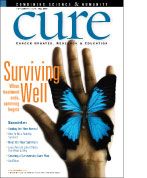Publication
Article
CURE
Fertility and Family
What cancer survivors need to know about post-treatment fertility and possibly side effects from treatment.
Preserving fertility has traditionally not been a consideration for young patients when survival is a first concern. But with more young survivors living longer, fertility has received growing attention that has resulted in surgical, medical, and technological advances that have enabled the medical community to provide fertility options for patients with cancer. The success of these options depends on the patient’s access to professionals in the field and the medical provider’s education prior to the beginning of treatment as well as the patient’s ability to cover some of the cost.
In June 2006, the American Society of Clinical Oncology published new guidelines that stated: “As part of education and informed consent before cancer therapy, oncologists should address the possibility of infertility with patients treated during their reproductive years and be prepared to discuss possible fertility preservation options or refer appropriate and interested patients to reproductive specialists.”
Unfortunately, many survivors did not discuss the topic before treatment, leaving them to learn after treatment that their options for biological parenting may have been eliminated.
Advocate Dan Shapiro, PhD, banked sperm before beginning treatment for Hodgkin disease in 1987 at age 19. As a result he has two biological daughters. But Shapiro says cancer does not have to end the chances for parenthood. “While it can end our chances to have biological children, I know many survivors who have chosen to adopt, foster parent, or who are stepparents,” Shapiro says.
For information on fertility, visit Fertile Hope at www.fertilehope.org. The national nonprofit organization provides reproductive information, support, and hope to those whose medical treatments present the risk of or have caused infertility.






